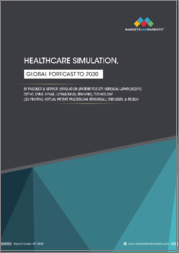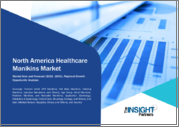
|
시장보고서
상품코드
1541045
세계의 의료 시뮬레이션 시장 보고서 : 제품 및 서비스, 충실도, 최종사용자, 지역별(2024-2032년)Medical Simulation Market Report by Product and Services, Fidelity, End User, and Region 2024-2032 |
||||||
세계의 의료 시뮬레이션 시장 규모는 2023년 25억 달러에 달했습니다. 앞으로 IMARC Group은 예측 기간 동안 11.8%의 복합 연간 성장률(CAGR)을 보일 전망이며 2032년에는 69억 달러에 달할 것으로 예측했습니다.
의료 시뮬레이션은 교육, 피드백 및 경험 학습을 위해 현장 활동을 가상으로 재현하는 것을 의미합니다. 의사, 간호사, 외과의사 및 기타 교육을 받은 의료 종사자는 안전한 환경에서 기술을 학습, 연습 및 평가하는 데 일반적으로 사용됩니다. 의료 시뮬레이션은 복강경, 부인과, 심장혈관, 관절경, 척수, 혈관 내, 치과, 안과 등의 시뮬레이션에 바디 마네킹, 작업 트레이너, 가상현실(VR) 기반 시스템 등을 사용합니다. 교수, 동료, 배우, 환자, 캠코더 등 옵저버의 피드백을 제공하여 환자의 안전성을 높이고 의사소통을 최적화하며 위기적인 자원 관리를 개선하는 데 도움이 됩니다. 그 결과 병원, 학술기관, 군사조직, 연구시설, 외래의료센터 등 폭넓은 용도로 이용되고 있습니다.
의료 시뮬레이션 시장 동향 :
세계의 의료 산업의 현저한 성장은 시장에 밝은 전망을 제공하는 주요 요인 중 하나입니다. 게다가 대중들 사이에서 시뮬레이션 기반 학습의 장점에 대한 인식이 높아지고 있다는 점도 시장 성장을 뒷받침하고 있습니다. 이에 따라 효과적인 암 치료를 위해 복강경 시뮬레이션 시스템이 널리 채용되고 있는 것도 시장의 성장에 기여하고 있습니다. 인터벤셔널 시뮬레이터의 증강현실(AR), 로봇공학, 인공지능(AI) 솔루션의 통합 등 다양한 기술적 진보가 다른 성장 촉진요인으로 작용하고 있습니다. 이 시뮬레이터는 담낭 절제술, 맹장 절제술, 위 우회술, 난관 결찰술, 자궁 절제술을 수행하는 의사의 훈련에 널리 사용됩니다. 환자의 안전성에 대한 우려가 증가하고, 특히 신흥 경제 국가에서 의료 산업의 급속한 디지털화와 같은 기타 요인들도 시장 성장을 뒷받침할 것으로 예상됩니다.
이 보고서에서 다루는 주요 질문
- 세계의 의료 시뮬레이션 시장은 지금까지 어떻게 추이해, 향후 어떻게 추이해 갈 것인가?
- COVID-19는 세계의 의료 시뮬레이션 시장에 어떤 영향을 미쳤는가?
- 주요 지역 시장은?
- 제품 및 서비스별 시장 분석은?
- 충실도별 시장 분석은?
- 최종 사용자별 시장 분석은?
- 업계의 밸류체인의 다양한 단계란?
- 업계의 주요 촉진요인과 도전은 무엇인가?
- 세계의 의료 시뮬레이션 시장의 구조와 주요 진출기업은?
- 업계 경쟁도는?
목차
제1장 서문
제2장 조사 범위와 조사 방법
- 조사의 목적
- 이해관계자
- 데이터 소스
- 1차 정보
- 2차 정보
- 시장 추정
- 상향식 접근
- 하향식 접근
- 조사 방법
제3장 주요 요약
제4장 소개
- 개요
- 주요 업계 동향
제5장 세계의 의료 시뮬레이션 시장
- 시장 개요
- 시장 실적
- COVID-19의 영향
- 시장 예측
제6장 시장 분석 : 제품 및 서비스별
- 모델 기반 시뮬레이션
- 외과 수술 시뮬레이션
- 초음파 시뮬레이션
- 웹 기반 시뮬레이션
- 시뮬레이션 트레이닝 서비스
제7장 시장 분석 : 충실도별
- 저
- 중
- 고
제8장 시장 분석 : 최종사용자별
- 병원 및 클리닉
- 학술기관과 연구센터
- 군사 조직
- 기타
제9장 시장 분석 : 지역별
- 북미
- 미국
- 캐나다
- 아시아태평양
- 중국
- 일본
- 인도
- 한국
- 호주
- 인도네시아
- 기타
- 유럽
- 독일
- 프랑스
- 영국
- 이탈리아
- 스페인
- 러시아
- 기타
- 라틴아메리카
- 브라질
- 멕시코
- 기타
- 중동 및 아프리카
- 시장 동향
- 시장 분석 : 국가별
- 시장 예측
제10장 SWOT 분석
- 개요
- 강점
- 약점
- 기회
- 위협
제11장 밸류체인 분석
제12장 Porter's Five Forces 분석
- 개요
- 구매자의 협상력
- 공급기업의 협상력
- 경쟁도
- 신규 진입업자의 위협
- 대체품의 위협
제13장 가격 분석
제14장 경쟁 구도
- 시장 구조
- 주요 기업
- 주요 기업 프로파일
- Cardionics Inc.(3B Scientific GmbH)
- Gaumard Scientific Company Inc.
- Kyoto Kagaku Co. Ltd
- Laerdal Medical
- Mentice
- Operative Experience Inc.
- Simbionix USA Corporation(3D Systems)
- Simulab Corporation
- Surgical Science Sweden AB
- Synaptive Medical Inc.
- SynBone AG
- VirtaMed AG
The global medical simulation market size reached US$ 2.5 Billion in 2023. Looking forward, IMARC Group expects the market to reach US$ 6.9 Billion by 2032, exhibiting a growth rate (CAGR) of 11.8% during 2024-2032.
Medical simulation refers to the virtual duplication of in-situ activities for training, feedback and experiential learning. It is commonly used by physicians, nurses, surgeons and other practitioners under training to learn, practice and assess their skills in a safe environment. Medical simulation uses body manikins, task trainers and virtual reality (VR)-based systems for laparoscopic, gynecological, cardiovascular, arthroscopic, spinal, endovascular, dental and eye simulation. It provides feedback from observers, such as professors, peers, actor-patients and video cameras, and aids in enhancing patient safety, optimizing communications and improving crisis resource management. As a result, it finds extensive applications across hospitals, academic institutes, military organizations, research facilities and ambulatory care centers.
Medical Simulation Market Trends:
Significant growth in the medical industry across the globe is among the key factors creating a positive outlook for the market. Moreover, the increasing awareness regarding the benefits of simulation-based learning among the masses is providing a thrust to the market growth. In line with this, the widespread adoption of laparoscopic simulation systems for effective cancer treatment is also contributing to the market growth. Various technological advancements, such as the integration of augmented reality (AR), robotics and artificial intelligence (AI) solutions in interventional simulators, are acting as other growth-inducing factors. These simulators are extensively used for training physicians in conducting cholecystectomy, appendectomy, gastric bypass, tubal ligation and hysterectomy. Other factors, including the rising concerns regarding patient safety, along with rapid digitization of the healthcare industry, especially in the developing economies, are anticipated to drive the market toward growth.
Key Market Segmentation:
IMARC Group provides an analysis of the key trends in each sub-segment of the global medical simulation market report, along with forecasts at the global, regional and country level from 2024-2032. Our report has categorized the market based on product and services, fidelity and end user.
Breakup by Product and Services:
Model-based Simulation
Surgical Simulation
Ultrasound Simulation
Web-based Simulation
Simulation Training Services
Breakup by Fidelity:
Low Fidelity
Medium Fidelity
High Fidelity
Breakup by End User:
Hospitals and Clinics
Academic Institutions and Research Centers
Military Organizations
Others
Breakup by Region:
North America
United States
Canada
Asia-Pacific
China
Japan
India
South Korea
Australia
Indonesia
Others
Europe
Germany
France
United Kingdom
Italy
Spain
Russia
Others
Latin America
Brazil
Mexico
Others
Middle East and Africa
Competitive Landscape:
The competitive landscape of the industry has also been examined along with the profiles of the key players being Cardionics Inc. (3B Scientific GmbH), Gaumard Scientific Company Inc., Kyoto Kagaku Co. Ltd, Laerdal Medical, Mentice, Operative Experience Inc., Simbionix USA Corporation (3D Systems), Simulab Corporation, Surgical Science Sweden AB, Synaptive Medical Inc., SynBone AG and VirtaMed AG.
Key Questions Answered in This Report:
- How has the global medical simulation market performed so far and how will it perform in the coming years?
- What has been the impact of COVID-19 on the global medical simulation market?
- What are the key regional markets?
- What is the breakup of the market based on the product and services?
- What is the breakup of the market based on the fidelity?
- What is the breakup of the market based on the end user?
- What are the various stages in the value chain of the industry?
- What are the key driving factors and challenges in the industry?
- What is the structure of the global medical simulation market and who are the key players?
- What is the degree of competition in the industry?
Table of Contents
1 Preface
2 Scope and Methodology
- 2.1 Objectives of the Study
- 2.2 Stakeholders
- 2.3 Data Sources
- 2.3.1 Primary Sources
- 2.3.2 Secondary Sources
- 2.4 Market Estimation
- 2.4.1 Bottom-Up Approach
- 2.4.2 Top-Down Approach
- 2.5 Forecasting Methodology
3 Executive Summary
4 Introduction
- 4.1 Overview
- 4.2 Key Industry Trends
5 Global Medical Simulation Market
- 5.1 Market Overview
- 5.2 Market Performance
- 5.3 Impact of COVID-19
- 5.4 Market Forecast
6 Market Breakup by Product and Services
- 6.1 Model-based Simulation
- 6.1.1 Market Trends
- 6.1.2 Market Forecast
- 6.2 Surgical Simulation
- 6.2.1 Market Trends
- 6.2.2 Market Forecast
- 6.3 Ultrasound Simulation
- 6.3.1 Market Trends
- 6.3.2 Market Forecast
- 6.4 Web-based Simulation
- 6.4.1 Market Trends
- 6.4.2 Market Forecast
- 6.5 Simulation Training Services
- 6.5.1 Market Trends
- 6.5.2 Market Forecast
7 Market Breakup by Fidelity
- 7.1 Low Fidelity
- 7.1.1 Market Trends
- 7.1.2 Market Forecast
- 7.2 Medium Fidelity
- 7.2.1 Market Trends
- 7.2.2 Market Forecast
- 7.3 High Fidelity
- 7.3.1 Market Trends
- 7.3.2 Market Forecast
8 Market Breakup by End User
- 8.1 Hospitals and Clinics
- 8.1.1 Market Trends
- 8.1.2 Market Forecast
- 8.2 Academic Institutions and Research Centers
- 8.2.1 Market Trends
- 8.2.2 Market Forecast
- 8.3 Military Organizations
- 8.3.1 Market Trends
- 8.3.2 Market Forecast
- 8.4 Others
- 8.4.1 Market Trends
- 8.4.2 Market Forecast
9 Market Breakup by Region
- 9.1 North America
- 9.1.1 United States
- 9.1.1.1 Market Trends
- 9.1.1.2 Market Forecast
- 9.1.2 Canada
- 9.1.2.1 Market Trends
- 9.1.2.2 Market Forecast
- 9.1.1 United States
- 9.2 Asia-Pacific
- 9.2.1 China
- 9.2.1.1 Market Trends
- 9.2.1.2 Market Forecast
- 9.2.2 Japan
- 9.2.2.1 Market Trends
- 9.2.2.2 Market Forecast
- 9.2.3 India
- 9.2.3.1 Market Trends
- 9.2.3.2 Market Forecast
- 9.2.4 South Korea
- 9.2.4.1 Market Trends
- 9.2.4.2 Market Forecast
- 9.2.5 Australia
- 9.2.5.1 Market Trends
- 9.2.5.2 Market Forecast
- 9.2.6 Indonesia
- 9.2.6.1 Market Trends
- 9.2.6.2 Market Forecast
- 9.2.7 Others
- 9.2.7.1 Market Trends
- 9.2.7.2 Market Forecast
- 9.2.1 China
- 9.3 Europe
- 9.3.1 Germany
- 9.3.1.1 Market Trends
- 9.3.1.2 Market Forecast
- 9.3.2 France
- 9.3.2.1 Market Trends
- 9.3.2.2 Market Forecast
- 9.3.3 United Kingdom
- 9.3.3.1 Market Trends
- 9.3.3.2 Market Forecast
- 9.3.4 Italy
- 9.3.4.1 Market Trends
- 9.3.4.2 Market Forecast
- 9.3.5 Spain
- 9.3.5.1 Market Trends
- 9.3.5.2 Market Forecast
- 9.3.6 Russia
- 9.3.6.1 Market Trends
- 9.3.6.2 Market Forecast
- 9.3.7 Others
- 9.3.7.1 Market Trends
- 9.3.7.2 Market Forecast
- 9.3.1 Germany
- 9.4 Latin America
- 9.4.1 Brazil
- 9.4.1.1 Market Trends
- 9.4.1.2 Market Forecast
- 9.4.2 Mexico
- 9.4.2.1 Market Trends
- 9.4.2.2 Market Forecast
- 9.4.3 Others
- 9.4.3.1 Market Trends
- 9.4.3.2 Market Forecast
- 9.4.1 Brazil
- 9.5 Middle East and Africa
- 9.5.1 Market Trends
- 9.5.2 Market Breakup by Country
- 9.5.3 Market Forecast
10 SWOT Analysis
- 10.1 Overview
- 10.2 Strengths
- 10.3 Weaknesses
- 10.4 Opportunities
- 10.5 Threats
11 Value Chain Analysis
12 Porters Five Forces Analysis
- 12.1 Overview
- 12.2 Bargaining Power of Buyers
- 12.3 Bargaining Power of Suppliers
- 12.4 Degree of Competition
- 12.5 Threat of New Entrants
- 12.6 Threat of Substitutes
13 Price Analysis
14 Competitive Landscape
- 14.1 Market Structure
- 14.2 Key Players
- 14.3 Profiles of Key Players
- 14.3.1 Cardionics Inc. (3B Scientific GmbH)
- 14.3.1.1 Company Overview
- 14.3.1.2 Product Portfolio
- 14.3.2 Gaumard Scientific Company Inc.
- 14.3.2.1 Company Overview
- 14.3.2.2 Product Portfolio
- 14.3.3 Kyoto Kagaku Co. Ltd
- 14.3.3.1 Company Overview
- 14.3.3.2 Product Portfolio
- 14.3.4 Laerdal Medical
- 14.3.4.1 Company Overview
- 14.3.4.2 Product Portfolio
- 14.3.4.3 SWOT Analysis
- 14.3.5 Mentice
- 14.3.5.1 Company Overview
- 14.3.5.2 Product Portfolio
- 14.3.5.3 Financials
- 14.3.6 Operative Experience Inc.
- 14.3.6.1 Company Overview
- 14.3.6.2 Product Portfolio
- 14.3.6.3 Financials
- 14.3.7 Simbionix USA Corporation (3D Systems)
- 14.3.7.1 Company Overview
- 14.3.7.2 Product Portfolio
- 14.3.8 Simulab Corporation
- 14.3.8.1 Company Overview
- 14.3.8.2 Product Portfolio
- 14.3.9 Surgical Science Sweden AB
- 14.3.9.1 Company Overview
- 14.3.9.2 Product Portfolio
- 14.3.9.3 Financials
- 14.3.10 Synaptive Medical Inc.
- 14.3.10.1 Company Overview
- 14.3.10.2 Product Portfolio
- 14.3.11 SynBone AG
- 14.3.11.1 Company Overview
- 14.3.11.2 Product Portfolio
- 14.3.12 VirtaMed AG
- 14.3.12.1 Company Overview
- 14.3.12.2 Product Portfolio
- 14.3.1 Cardionics Inc. (3B Scientific GmbH)



















